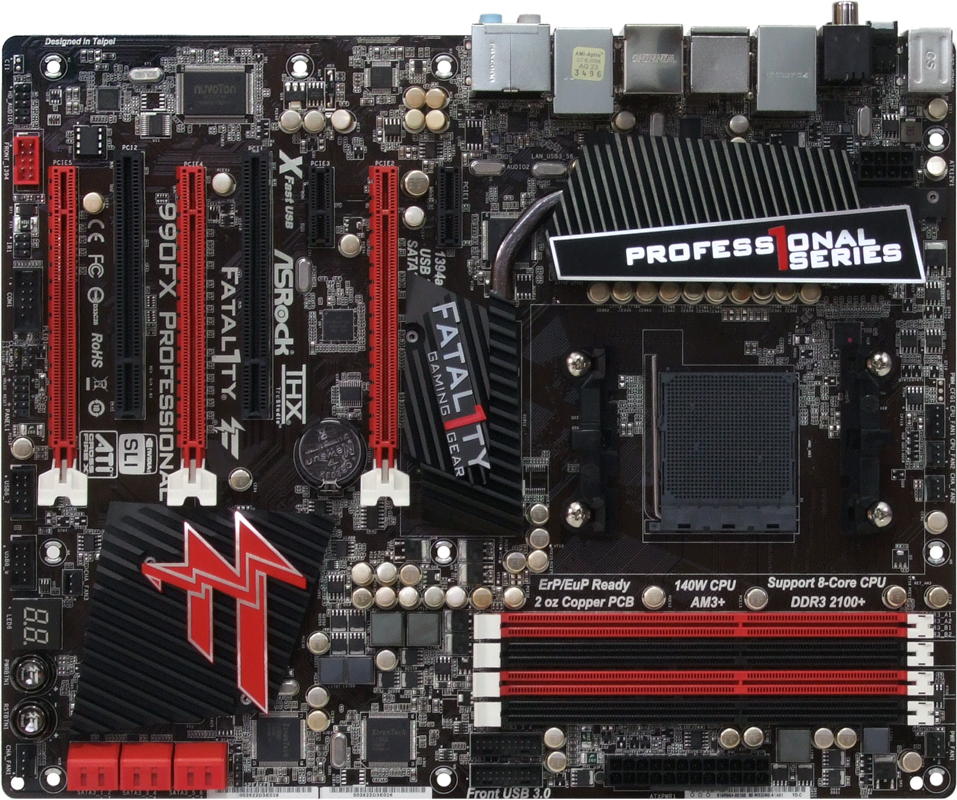Five $160 To $240 990FX-Based Socket AM3+ Motherboards
Forty-two PCIe lanes give the 990FX a clear connectivity lead over competing Intel chipsets. We compare five class-leading products using AMD's FX-8150 to see which offers the best combination of performance, overclocking, integrated features, and value.
ASRock Fatal1ty 990FX Professional
A trio of USB 3.0 controllers, a pair of high-performance BCM57781 network controllers, and a sharp-looking red-on-black color scheme all set ASRock’s Fatal1ty 990FX Professional apart from similarly-priced competitors. Meanwhile, a large “clear CMOS” button on the I/O panel professes this model’s high-end overclocking intentions.
Spread three spaces apart for better GPU cooling, the top two PCIe x16 slots are both fixed with true x16 pathways to assure the best possible performance in two-way SLI or CrossFire. We didn’t really expect three-way SLI support from a sub-$200 motherboard, so the bottom slot’s four-lane limitation is only a minor disappointment. The slot could potentially be used in a three-way CrossFire configuration, though its modest bandwidth is better suited to high-end storage controllers, network devices, an dedicated GeForce graphics card for independent PhysX calculations, or additional 2D-only displays.
AMD’s SB950 southbridge feeds all six of the Fatal1ty 990FX Professional’s internal SATA 6Gb/s ports. Rather than give us a bunch of extra internal SATA controllers that most builders probably wouldn't use anyway, ASRock decided to try something different by adding a second internal header for a total of four front-panel USB 3.0 ports. Because USB 3.0 cables are notoriously thick and stiff, ASRock smartly places them above the add-in card slots for better clearance.
The Fatal1ty 990FX layout is very good overall, though we did notice a few small issues. For example, the single-sided DIMM latches originally designed to let you pull memory sticks without popping your graphics card out first face the wrong way, and some older case designs lack drive cage clearance for the forward-facing SATA ports. Overall, the port design makes sense because you're more likely to need vertical card clearance, but the potential for conflict still exists.
The most pleasing part of the Fatal1ty 990FX Professional motherboard’s bundle is its inclusion of a full set of six SATA cables, though we also really like the fact that ASRock adds a 3.5” bay adapter for cases that lack a front-panel USB 3.0 connector. Barely visible atop the installation manual are a single SLI bridge and audio patch cable.
ASRock offers a three-year warranty on specific high-end models, including the Fatal1ty 990FX Professional, but has not yet added a list of applicable models to its RMA policy page. We mention that only because we prefer to see our warranty coverage in writing!
Get Tom's Hardware's best news and in-depth reviews, straight to your inbox.
Current page: ASRock Fatal1ty 990FX Professional
Prev Page 990FX: AMD Leads The Chipset Game Next Page Fatal1ty 990FX Professional Firmware-
timbo1130 How is this relevant to enthusiast? Bulldozer is out classed by Sandy Bridge I don't care if there are a few less sata ports. If you need to upgrade your better off going with Sandy bridge and z68 or p67 or wait for SB-E and X79.Reply -
julianbautista87 thanks for this article. I was waiting for it since some guy said that the 8150 was performing badly because of the mainboard used, but now I see that that was not correct.Reply -
_Pez_ Yeah If were to buy this boards would be with a Phenom real 6 core CPU 1100T :D that is the smartest choice. I think.Reply -
frostweaver I would wait till next year to decide. I still feel that windows 7 aint optimized for BD.Reply -
Tijok First off, thanks for the great article, good to see Tom's is keeping up the top notch quality!Reply
Secondly, I would really like to see a piece on extreme CFX/SLI configurations on rigs like this. It seems an article with reliable information on this would be beneficial to gaming enthusiasts, IT professionals, and HPC builders alike!
Hope to see an article along these lines soon! -
palladin9479 I bought the Sabertooth during the summer and I can attest to how amazing that board is. It's really nice, lots of features and high quality. I'm running a Phenom II X4 970BE @ 4.3Ghz on water right now. Absolutely wonderful system.Reply -
ta152h What a bunch of pretzel logic we have in this article.ReplyOf course, a fan of Intel's work could argue against the need for 42 lanes of second-gen PCIe when the 36 native to X58 Express support multi-card graphics configurations just as capably. But such a comparison really isn't necessary. After all, we've known for almost a year that Intel’s lower-cost Sandy Bridge-based part outperform the pricey six-core Gulftown-based processors in many desktop benchmarks, including pretty much every gaming scenario we throw at the two platforms.
So, x58 is irrelevant, because SB beats it. Except AMD's offering is somehow relevant even though both x58 and SB beat it. What?????
If you ignore x58 because SB offers better performance, you ignore anything AMD has because a SB setup offers better performance. If you want 36 or less lanes, x58 still offers better processors than you can hope to get from AMD. Bizarre logic.
Not that AMD is irrelevant, just the logic is badly flawed.



